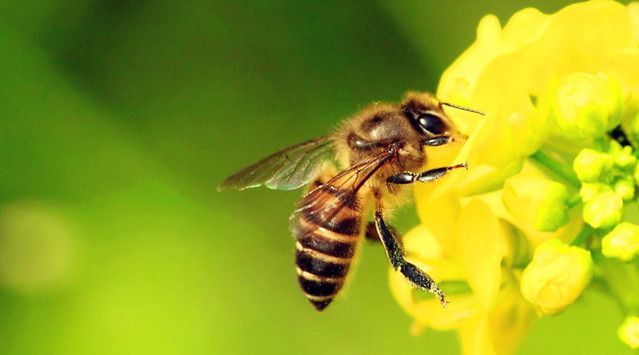(单词翻译:单击)
听力文本
This is Scientific American — 60-Second Science. I'm Christopher Intagliata.
Springtime is flower season. And that includes some 90 million almond trees in California. It's the largest pollination event in the U.S.—and beekeepers truck in two thirds of the nation's captive honeybees to do the job. But for the last decade or so, the keepers have complained about failing colonies, with underdeveloped bees ejected from their hives.
Now a study identifies one possible culprits. Not a pesticide, but one of the many ingredients used alongside them. "So these are added into a formulation to enhance the efficacy of the active ingredients." Julia Fine, an entomologist at Penn State. "It's just called "other ingredients" and they often are the bulk of the formulated product."

The chemical in question is known as an organosilicone surfactant. Fine and her colleagues fed the chemical to honeybee larvae over time, and exposed them to a cocktail of common beehive viruses. And they found that larvae exposed to the chemical and the viruses together appeared to die in greater numbers than did bees exposed to the viruses or the chemical alone—so there's a possible synergistic effect that play. And the symptoms they saw mirrored the ones beekeepers observed in their hives. The study is in the journal Scientific Reports.
Fine and her team still have to determine how much of these chemicals actually make it into the bees' food. But they do know hundreds of thousands of pounds of them are used in almond orchards each year. And elsewhere too. "Agriculture is just one use for organosilicone surfactants. It's all over the place. So if we can find it has any effect in an organism, it will be relevant."
Thanks for listening for Scientific American — 60-Second Science Science. I'm Christopher Intagliata.
参考译文
这里是科学美国人——60秒科学。我是克里斯托弗·因塔利亚塔。
春天是鲜花盛开的季节。加利福尼亚州约9000万棵杏树自然也不例外。这是美国规模最大的授粉事件,养蜂人用美国三分之二的蜜蜂来做授粉工作。但是,过去十年,这些养蜂人一直抱怨蜂群数量不断减少,原因是一些未充分发育的蜜蜂被赶出蜂巢。
现在一项研究确定了可能的罪魁祸首。不是农药,而是很多农药中都含有的一种成分。“这些成分添加到农药中以提高农药的有效性。”朱莉娅·范恩是宾州州立大学的昆虫学家。“我们通常称之为‘其他成分',许多配方产品中都含有这些成分。”
上文提到的化学物质是一种有机硅表面活性剂。一段时间以来,范恩和她的同事将这种物质喂给蜜蜂的幼虫,并让这些幼虫接触常见蜂巢病毒的混合物。他们发现,接触这种化学成分和病毒的幼虫的死亡数量要远远多于仅接触化学成分或者仅接触病毒的幼虫,这可能是一种协同效应。研究人员所看到的症状反应了养蜂人在蜂巢中观察到的现象。该研究结果发表在《科学报告》期刊。
范恩和她的团队还必须确定有多少化学物质成为了蜜蜂的食物。不过,他们知道这种化学物质每年被大量的应用在于杏园中。同时也用在其他地方。“不仅仅是农业应用有机硅表面活性剂。各个地方都在用这种物质。如果我们能发现它对有机物产生影响,那就存在相关性。”
谢谢大家收听科学美国人——60秒科学。我是克里斯托弗·因塔利亚塔。
译文为可可英语翻译,未经授权请勿转载!
重点讲解
重点讲解:
1. eject from 驱逐;把…逐出;
例句:The heckler was ejected from the meeting.
那个捣乱分子被驱逐出会场。
2. in question 被提及的;讨论中的;相关的;
例句:Here are the two students in question.
这就是我们所谈到的两个学生。
3. be exposed to 使受…的影响;使接触;
例句:The worker was exposed to several dangerous chemicals.
这位工作者接触许多危险的化学药品。
4. all over 到处;遍及;
例句:The company has a network of shops all over the country.
这家公司有着遍布全国的商店网。


